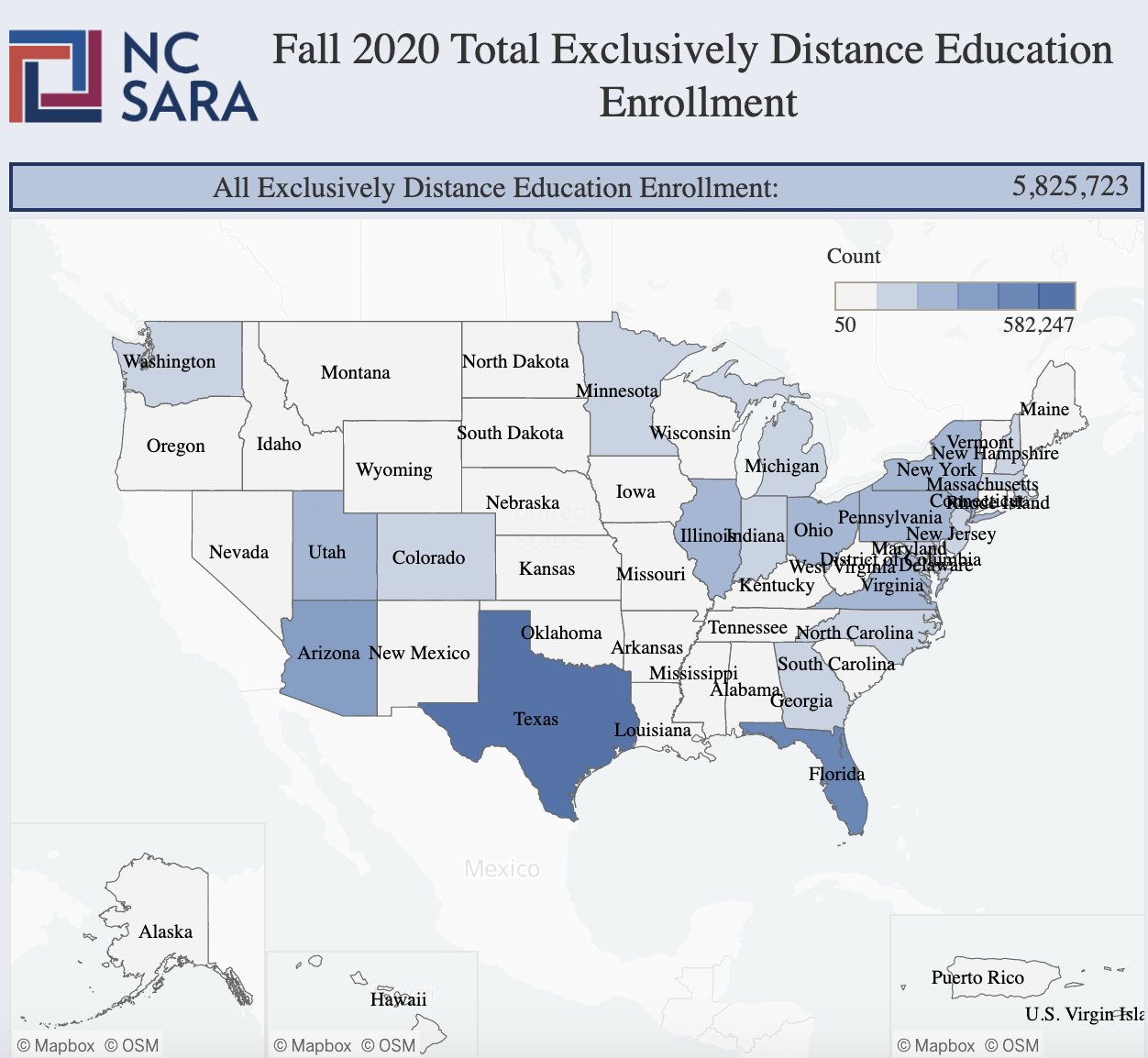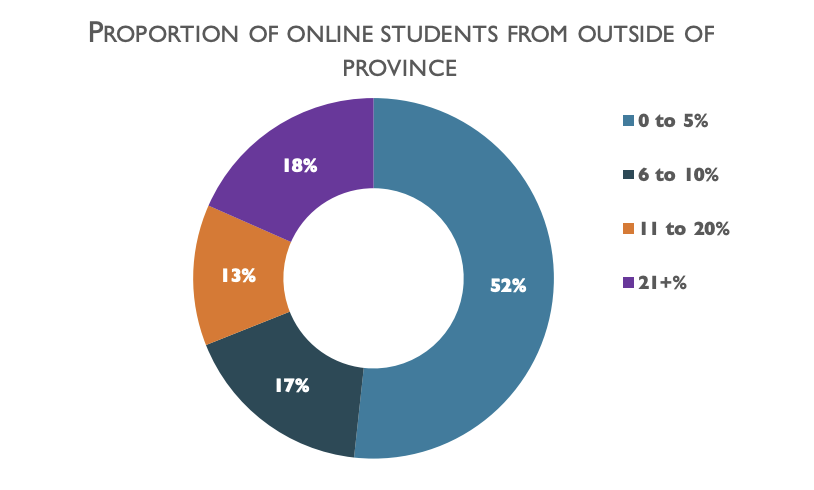
NC-SARA (2021) NC-SARA Institution Survey: Perspectives on the Pandemic Boulder CO: NC-SARA
This report gives some interesting information about the actual number of students and institutions in the USA that moved to fully distance learning during the pandemic, and I will also be discussing inter-jurisdictional distance education enrolments, both in the USA and Canada. However, I need to explain how data are collected on distance education enrolments in both the USA and Canada before I can look at the NC-SARA survey results.
Tracking distance education enrolments in the USA and Canada
The USA has much better data on post-secondary distance education (and by implication, online learning) than Canada. In the USA, a federal agency, the National Centre for Education Statistics, has a program, the Integrated Postsecondary Education System (IPEDS), dedicated to collecting data on post-secondary enrolments. This includes data on distance education enrolments. Being a Federal agency similar to Statistics Canada, institutions are legally obliged to complete IPEDS’ surveys. IPEDS provides each institution with specific definitions of distance education courses. This ensures very high completion rates and, in general, highly reliable data.
However, IPEDS provides just the data in the form of tables. It does not interpret or otherwise editorialise the results (hey, it’s the government). However, because the data and tables are openly accessible, online and distance education researchers, such as Jeff Seaman at Bay View Analytics and Phil Hill of PhilOnEdTech, provide such analysis and reports based on the IPEDS data.
In contrast, although Statistics Canada collects data on overall enrolments in Canadian post-secondary institutions, it does not collect information specifically on distance education or online enrolments. Consequently, a non-profit association, the Canadian Digital Learning Research Association (CDLRA), was established in 2017 to collect and publish such data. Although, unlike in the USA and for Statistics Canada, institutional participation in CDLRA surveys is voluntary, nevertheless CDLRA response rates have been high (in the order of 80%+ of all institutions on the roster). Despite this, the enrolment data are not always reliable because there is no federal or often no provincial requirement to collect such data, and no agreed definitions, so reporting quality varies from institution to institution, although the CDLRA, together with CIRPA (institutional researchers) are working on this.
In the USA, ‘higher education stakeholders – including state regulators and education leaders, accreditors, the U.S. Department of Education, and institutions – joined together in 2013 to establish the State Authorization Reciprocity Agreements (SARA), which streamline regulations around distance education programs. Today, more than 2,200 institutions in 49 member states, the District of Columbia, Puerto Rico, and the U.S. Virgin Islands all voluntarily participate in SARA.’ (California is the only major state that does not participate in SARA.)
One of the areas that the National Council of SARA (NC-SARA) focuses on is inter-state transferability of credit and recognition for out-of-state students taking distance education courses from other states than the one in which they reside. Because IPEDS data do not distinguish between out-of-state and in-state distance education enrolments, NC-SARA also conducts a voluntary annual survey of institutions in all member states. It collects not only data on out-of-state learning placements (OOSLP) but also exclusively distance education enrolments (EDE). These surveys give a good idea not only of the number of students taking exclusively distance education courses from each state, but also which states are the main ‘importers’ and ‘exporters’ of distance education. There is no organisation in Canada equivalent to NC-SARA that tracks out-of-province distance education enrolments (although in theory CDLRA could, if institutions themselves were to track this information – at the moment some do but most don’t).
The NC-SARA study on perspectives on Covid
Because NC-SARA has been tracking out-of-state and in-state distance education enrolments annually, it has been able to compare the impact of Covid-19 on fully distance education enrolments for the fall semester of 2020. It surveyed 2,100 institutions and received responses from just under 700, for a response rate of 32%.
Main results
This is just a selection. Read the actual report for more details:
- 85% of institutions moved in-person courses to emergency remote learning
- the majority of the 15% that did not move to emergency remote learning were either fully online before the pandemic (25%) or were small, private institutions
- 59% of the responding institutions plan to continue to offer some or all of their emergency remote classes via distance education when the pandemic is over.
My comments on the NC-SARA report
- Although the response rate (32%) is low, NC-SARA reported that the sample is roughly representative of its members
- note that this report is about students who are taking all their courses at a distance; it does not include the many students who are taking a mix of distance and in-person courses
- it is received wisdom that nearly all institutions in the USA moved to emergency remote or distance learning during Covid-19, but it is still useful to have actual data (85%) that confirms this
- similarly, it has been generally assumed that some of the courses previously offered in-person will continue to be offered online post-pandemic, but it is helpful to have a figure for the proportion of institutions that plan to keep courses online/at a distance that were previously in-person – just over half of all institutions (59%).
Other NC-SARA data
NC-SARA keeps an interesting set of data dashboards that summarise the data from their surveys, particularly with regard to students studying out-of-state. These indicate the following:
- in 2020, 68% of the 5,825,723 students who were exclusively enrolled in distance education courses took their courses from an institution within their state and 32% took their courses from an out-of-state provider. Texas and Florida were the states with the highest proportion of in-state DE students. Western Governors University (147,000) and the University of Southern New Hampshire (127,000) had the highest numbers of fully distance students.
- however, Arizona, followed by Utah, had the highest proportion of fully distance students coming from out-of-state
- Texas and Florida (and also California) had the most fully distance students going to other states for their courses.
Comparison with Canada
It is interesting that almost a third of all students studying entirely at a distance in the USA are doing so at institutions that are not in their own state. There is clearly a good deal of inter-state traffic in the USA in distance education.
In Canada, we know that there are high rates of international students. Prior to Covid, international students represented 17% of total university enrolments and 19% of college enrolments (Statistics Canada, 2021). In contrast, in 2018-19, the last year for which data are available, the proportion of all Canadian undergraduates who were studying in another province was much lower, at about 8.4% (Usher, 2021).
The proportion of Canadian online or distance students studying out of province though is even lower. The CDLRA (2019) reported that in 2018 only 39% of institutions with online offerings reported that they tracked this data and were able to provide actual numbers. It is also interesting that so few institutions are interested in tracking the origin of their distance education students.

Among those institutions that did track, or could estimate, the location of their online students, the majority (52%) reported that only 5% or less of their online students are coming from outside of the province. A further 17% stated that between 6 and 10% of their online students are from outside the province and 13% reported that between 10 and 20% of their online students are residing outside of the province.
Less than one-in-five institutions (18%) have 20% or more of their online students that live outside of the province. This is somewhat surprising, since over 85% of Canadian institutions reported that online education is strategically important for attracting students from outside their traditional service area.
There certainly seems to be room for growth in Canada for out-of-province distance or online enrolments, at least in comparison with the USA. Or are Canadian students just less mobile? Provincial barriers to credit transfer may be a reason for this. Perhaps Canada needs the equivalent of NC-SARA.









 Dr. Tony Bates is the author of eleven books in the field of online learning and distance education. He has provided consulting services specializing in training in the planning and management of online learning and distance education, working with over 40 organizations in 25 countries. Tony is a Research Associate with Contact North | Contact Nord, Ontario’s Distance Education & Training Network.
Dr. Tony Bates is the author of eleven books in the field of online learning and distance education. He has provided consulting services specializing in training in the planning and management of online learning and distance education, working with over 40 organizations in 25 countries. Tony is a Research Associate with Contact North | Contact Nord, Ontario’s Distance Education & Training Network.

